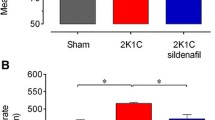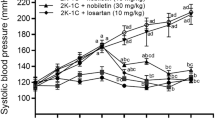Abstract
Endothelial dysfunction contributes to the initiation and development of hypertension. We previously found that simvastatin moderately decreases blood pressure in 2-kidney-2-clip (2k2c) renal hypertension, but the precise mechanisms are still unclear. The present study was designed to examine the protective actions of simvastatin in 2k2c-evoked endothelial dysfunction and also delineate the underlying mechanisms. Here we show that 2k2c-induced elevation in plasma angiotensin II impaired acetylcholine-induced endothelium-dependent vascular relaxation, suppressed endothelial NO synthase (eNOS) activity and reduced nitric oxide (NO) production. Additionally, the levels of tetrahydrobiopterin (BH4), an essential cofactor of eNOS, as well as the activity of GTP cyclohydrolase I (GTPCH I), the rate-limiting enzyme for BH4 synthesis, were markedly reduced. Administration of simvastatin significantly improved acetylcholine-induced endothelium-dependent carotid arteries relaxation at 9 weeks in reno-hypertensive rats. Notably, GTPCH I activity, BH4 production, p-eNOS expression and NO levels in the vascular endothelium were elevated as a result of simvastatin administration. In cultured rat arterial endothelial cells, simvastatin restored BH4, GTPCH I activity and NO release impaired by angiotensin II, and pretreatment with mevalonate (MVA) or geranylgeranyl pyrophosphate (GGPP) abolished the beneficial effects exerted by simvastatin. Moreover, RhoA inhibitor C3 exoenzyme, Rho kinase inhibitor Y-27632 and dominant negative mutant of RhoA prevented BH4 and NO loss due to Ang II treatment. Taken together, normalization of BH4-eNOS-NO pathway at least in part accounts for the beneficial actions of simvastatin on vascular endothelium during 2k2c hypertension, and RhoA-Rho kinase pathway is involved in regulation of BH4 production.





Similar content being viewed by others
References
Tang EH, Vanhoutte PM. Endothelial dysfunction: a strategic target in the treatment of hypertension? Pflugers Arch. 2010;459:995–1004.
Willerson JT, Kereiakes DJ. Endothelial dysfunction. Circulation. 2003;108:2060–1.
Kawashima S, Yokoyama M. Dysfunction of endothelial nitric oxide synthase and atherosclerosis. Arterioscler Thromb Vasc Biol. 2004;24:998–1005.
Hong HJ, Hsiao G, Cheng TH, Yen MH. Supplemention with tetrahydrobiopterin suppresses the development of hypertension in spontaneously hypertensive rats. Hypertension. 2001;38:1044–8.
Bevers LM, Braam B, Post JA, van Zonneveld AJ, Rabelink TJ, Koomans HA, et al. Tetrahydrobiopterin, but not L-arginine, decreases NO synthase uncoupling in cells expressing high levels of endothelial NO synthase. Hypertension. 2006;47:87–94.
Kang KT, Sullivan JC, Spradley FT, d’Uscio LV, Katusic ZS, Pollock JS. Antihypertensive therapy increases tetrahydrobiopterin levels and NO/cGMP signaling in small arteries of angiotensin II-infused hypertensive rats. Am J Physiol Heart Circ Physiol. 2011;300:H718–24.
Landmesser U, Dikalov S, Price SR, McCann L, Fukai T, Holland SM, et al. Oxidation of tetrahydrobiopterin leads to uncoupling of endothelial cell nitric oxide synthase in hypertension. J Clin Invest. 2003;111:1201–9.
Meininger CJ, Cai S, Parker JL, Channon KM, Kelly KA, Becker EJ, et al. GTP cyclohydrolase I gene transfer reverses tetrahydrobiopterin deficiency and increases nitric oxide synthesis in endothelial cells and isolated vessels from diabetic rats. FASEB J. 2004;18:1900–2.
Cai S, Khoo J, Mussa S, Alp NJ, Channon KM. Endothelial nitric oxide synthase dysfunction in diabetic mice: importance of tetrahydrobiopterin in eNOS dimerisation. Diabetologia. 2005;48:1933–40.
Hattori Y, Hattori S, Wang X, Satoh H, Nakanishi N, Kasai K. Oral administration of tetrahydrobiopterin slows the progression of atherosclerosis in apolipoprotein E-knockout mice. Arterioscler Thromb Vasc Biol. 2007;27:865–70.
Mitchell BM, Dorrance AM, Webb RC. GTP cyclohydrolase 1 inhibition attenuates vasodilation and increases blood pressure in rats. Am J Physiol Heart Circ Physiol. 2003;285:H2165–70.
Du YH, Guan YY, Alp NJ, Channon KM, Chen AF. Endothelium-specific GTP cyclohydrolase I overexpression attenuates blood pressure progression in salt-sensitive low-renin hypertension. Circulation. 2008;117:1045–54.
Zheng JS, Yang XQ, Lookingland KJ, Fink GD, Hesslinger C, Kapatos G, et al. Gene transfer of human guanosine 5′-triphosphate cyclohydrolase I restores vascular tetrahydrobiopterin level and endothelial function in low renin hypertension. Circulation. 2003;108:1238–45.
Nassief A, Marsh JD. Statin therapy for stroke prevention. Stroke. 2008;39:1042–8.
Wenzel P, Daiber A, Oelze M, Brandt M, Closs E, Xu J, et al. Mechanisms underlying recoupling of eNOS by HMG-CoA reductase inhibition in a rat model of streptozotocin-induced diabetes mellitus. Atherosclerosis. 2008;198:65–76.
Whaley-Connell A, Habibi J, Nistala R, Cooper SA, Karuparthi PR, Hayden MR, et al. Attenuation of NADPH oxidase activation and glomerular filtration barrier remodeling with statin treatment. Hypertension. 2008;51:474–80.
Goldstein LB, Amarenco P, Lamonte M, Gilbert S, Messig M, Callahan A, et al. Relative effects of statin therapy on stroke and cardiovascular events in men and women: secondary analysis of the Stroke Prevention by Aggressive Reduction in Cholesterol Levels (SPARCL) Study. Stroke. 2008;39:2444–8.
Liu YJ, Wang XG, Tang YB, Chen JH, Lv XF, Zhou JG, et al. Simvastatin ameliorates rat cerebrovascular remodeling during hypertension via inhibition of volume-regulated chloride channel. Hypertension. 2010;56:445–52.
Kolavennu V, Zeng L, Peng H, Wang Y, Danesh FR. Targeting of RhoA/ROCK signaling ameliorates progression of diabetic nephropathy independent of glucose control. Diabetes. 2008;57:714–23.
Li J, Xie ZZ, Tang YB. Genistein prevents myocardial hypertrophy in 2-kidney 1-clip renal hypertensive rats by restoring eNOS pathway. Pharmacology. 2010;86:240–8.
Du RH, Tang YB, Zhou JG, Guan YY. Effects of Tween 80 on volume-regulated chloride channel and cell proliferation in rat basilar artery smooth muscle cell. J Pharm Pharmacol. 2011;63:253–60.
Wallerath T, Witte K, Schafer SC, Schwarz PM, Prellwitz W, Wohlfart P, et al. Down-regulation of the expression of endothelial NO synthase is likely to contribute to glucocorticoid-mediated hypertension. Proc Natl Acad Sci U S A. 1999;96:13357–62.
Ming XF, Viswambharan H, Barandier C, Ruffieux J, Kaibuchi K, Rusconi S, et al. Rho GTPase/Rho kinase negatively regulates endothelial nitric oxide synthase phosphorylation through the inhibition of protein kinase B/Akt in human endothelial cells. Mol Cell Biol. 2002;22:8467–77.
Ruiz P, Basso N, Grinspon D, Mangiarua E, Cannata MA. Angiotensinogen concentration in the cerebrospinal fluid in different experimental conditions in the rat. Hypertension. 1983;5:V29–33.
Sun Y, Carretero OA, Xu J, Rhaleb NE, Yang JJ, Pagano PJ, et al. Deletion of inducible nitric oxide synthase provides cardioprotection in mice with 2-kidney, 1-clip hypertension. Hypertension. 2009;53:49–56.
Crabtree MJ, Channon KM. Synthesis and recycling of tetrahydrobiopterin in endothelial function and vascular disease. Nitric Oxide.
Iwanciw D, Rehm M, Porst M, Goppelt-Struebe M. Induction of connective tissue growth factor by angiotensin II: integration of signaling pathways. Arterioscler Thromb Vasc Biol. 2003;23:1782–7.
Rossoni LV, Wareing M, Wenceslau CF, Al-Abri M, Cobb C, Austin C. Acute simvastatin increases endothelial nitric oxide synthase phosphorylation via AMP-activated protein kinase and reduces contractility of isolated rat mesenteric resistance arteries. Clin Sci (Lond). 2011;121:449–58.
Li X, Wang P, Xu X, Wang Y, Xia Y, Wang D. Simvastatin increases the activity of endothelial nitric oxide synthase via enhancing phosphorylation. Journal of Huazhong University of Science and Technology Medical sciences = Hua zhong ke ji da xue xue bao Yi xue Ying De wen ban = Huazhong keji daxue xuebao. 2009;29:286–90.
Wang S, Xu J, Song P, Wu Y, Zhang J. Chul Choi H, et al. Acute inhibition of guanosine triphosphate cyclohydrolase 1 uncouples endothelial nitric oxide synthase and elevates blood pressure. Hypertension. 2008;52:484–90.
Li L, Rezvan A, Salerno JC, Husain A, Kwon K, Jo H, et al. GTP cyclohydrolase I phosphorylation and interaction with GTP cyclohydrolase feedback regulatory protein provide novel regulation of endothelial tetrahydrobiopterin and nitric oxide. Circ Res. 2010;106:328–36.
Artunc F, Essig M, Artunc N, Plachtzik C, Reich M, Boehmer G, et al. Effects of tetrahydrobiopterin on nitric oxide bioavailability and renal hemodynamics in healthy volunteers. J Nephrol. 2008;21:850–60.
Moens AL, Takimoto E, Tocchetti CG, Chakir K, Bedja D, Cormaci G, et al. Reversal of cardiac hypertrophy and fibrosis from pressure overload by tetrahydrobiopterin: efficacy of recoupling nitric oxide synthase as a therapeutic strategy. Circulation. 2008;117:2626–36.
Sources of Funding
This work was supported by the National Natural Science Foundation of China (No.30900530), Science and Technology Planning Project of Guangdong Province, China (No.2008B030303061; No.2008B080703056; NO.2010B080701044; 2011B080701012), and Doctoral Fund of Ministry of Education of China (for young teachers, No.20090171120055).
Disclosures
None.
Author information
Authors and Affiliations
Corresponding authors
Additional information
Zheng Zhang and Mi Wang contributed equally to this work.
Rights and permissions
About this article
Cite this article
Zhang, Z., Wang, M., Xue, SJ. et al. Simvastatin Ameliorates Angiotensin II-Induced Endothelial Dysfunction Through Restoration of Rho-BH4-eNOS-NO Pathway. Cardiovasc Drugs Ther 26, 31–40 (2012). https://doi.org/10.1007/s10557-011-6351-3
Published:
Issue Date:
DOI: https://doi.org/10.1007/s10557-011-6351-3




